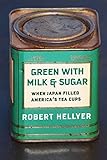Green with Milk and Sugar : When Japan Filled America’s Tea Cups / Robert Hellyer.
Material type: TextPublisher: New York, NY : Columbia University Press, [2021]Copyright date: 2021Description: 1 online resource : 35 b&w figuresContent type:
TextPublisher: New York, NY : Columbia University Press, [2021]Copyright date: 2021Description: 1 online resource : 35 b&w figuresContent type: - 9780231199100
- 9780231552943
- 382/.413720952 23/eng/20240417
- HD9198.U52 H45 2024
- online - DeGruyter
| Item type | Current library | Call number | URL | Status | Notes | Barcode | |
|---|---|---|---|---|---|---|---|
 eBook
eBook
|
Biblioteca "Angelicum" Pont. Univ. S.Tommaso d'Aquino Nuvola online | online - DeGruyter (Browse shelf(Opens below)) | Online access | Not for loan (Accesso limitato) | Accesso per gli utenti autorizzati / Access for authorized users | (dgr)9780231552943 |
Frontmatter -- CONTENTS -- NOTES ON CONVENTIONS -- PREFACE -- INTRODUCTION -- 1. THE FOUNDATIONS OF TEAWAYS IN JAPAN AND THE UNITED STATES -- 2. TEA AMID CIVIL WARS -- 3. MAKING JAPAN TEA -- 4 THE MIDWEST: GREEN TEA COUNTRY -- 5. THE BLACK TEA WAVE HITS AMERICA -- 6. DAILY CUPS DEFINED: BLACK TEA IN THE UNITED STATES, SENCHA IN JAPAN -- CONCLUSION -- ACKNOWLEDGMENTS -- NOTES -- SELECTED BIBLIOGRAPHY -- INDEX
restricted access online access with authorization star
http://purl.org/coar/access_right/c_16ec
Today, Americans are some of the world’s biggest consumers of black teas; in Japan, green tea, especially sencha, is preferred. These national partialities, Robert Hellyer reveals, are deeply entwined. Tracing the trans-Pacific tea trade from the eighteenth century onward, Green with Milk and Sugar shows how interconnections between Japan and the United States have influenced the daily habits of people in both countries.Hellyer explores the forgotten American penchant for Japanese green tea and how it shaped Japanese tastes. In the nineteenth century, Americans favored green teas, which were imported from China until Japan developed an export industry centered on the United States. The influx of Japanese imports democratized green tea: Americans of all classes, particularly Midwesterners, made it their daily beverage—which they drank hot, often with milk and sugar. In the 1920s, socioeconomic trends and racial prejudices pushed Americans toward black teas from Ceylon and India. Facing a glut, Japanese merchants aggressively marketed sencha on their home and imperial markets, transforming it into an icon of Japanese culture.Featuring lively stories of the people involved in the tea trade—including samurai turned tea farmers and Hellyer’s own ancestors—Green with Milk and Sugar offers not only a social and commodity history of tea in the United States and Japan but also new insights into how national customs have profound if often hidden international dimensions.
Mode of access: Internet via World Wide Web.
In English.
Description based on online resource; title from PDF title page (publisher's Web site, viewed 20. Nov 2024)


